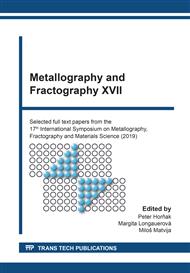[1]
I. Campbell, D. Bourell, I. Gibson, Additive manufacturing: rapid prototyping comes of age, Rapid Prototyping Journal 18 (2012) 255-258.
DOI: 10.1108/13552541211231563
Google Scholar
[2]
J.P. Kruth, B. Vandenbroucke, Selective laser melting of biocompatible metals for rapid manufacturing of medical parts, Rapid Prototyping Journal 13 (2007) 196-203.
DOI: 10.1108/13552540710776142
Google Scholar
[3]
D. Herzog, V. Seyda, E. Wycisk, C. Emmelmann, Additive manufacturing of metals, Acta Materialia 117 (2016) 371-392.
DOI: 10.1016/j.actamat.2016.07.019
Google Scholar
[4]
S. Bagherifard, N. Beretta, S. Monti, M. Riccio, M. Bandini, M. Guagliano, On the fatigue strength enhancement of additive manufactured AlSi10Mg parts by mechanical and thermal post-processing, Materials & Design 145 (2018) 28-41.
DOI: 10.1016/j.matdes.2018.02.055
Google Scholar
[5]
N.E. Uzan, S. Ramati, R. Shneck, N. Frage, O. Yeheskel, On the effect of shot-peening on fatigue resistance of AlSi10Mg specimens fabricated by additive manufacturing using selective laser melting (AM-SLM), Additive Manufacturing 21 (2018) 458-464.
DOI: 10.1016/j.addma.2018.03.030
Google Scholar
[6]
B. Van Hooreweder, Y. Apers, K. Lietaert, J.-P. Kruth, Improving the fatigue performance of porous metallic biomaterials produced by Selective Laser Melting, Acta Biomaterialia 47 (2017) 193-202.
DOI: 10.1016/j.actbio.2016.10.005
Google Scholar
[7]
Y. Zhang, J. Li, S. Che, Electropolishing mechanism of Ti-6Al-4V alloy fabricated by selective laser melting, International Journal of Electrochemical Science 13 (2018) 4792-4807.
DOI: 10.20964/2018.05.79
Google Scholar
[8]
K.L. Tan, S.H. Yeo, Surface modification of additive manufactured components by ultrasonic cavitation abrasive finishing, Wear 378-379 (2017) 90-95.
DOI: 10.1016/j.wear.2017.02.030
Google Scholar
[9]
B. Zhang, Y. Li, Q. Bai, Defect Formation Mechanisms in Selective Laser Melting: A Review, Chinese Journal of Mechanical Engineering 30 (2017) 515-527.
DOI: 10.1007/s10033-017-0121-5
Google Scholar
[10]
S. Tammas-Williams, P.J. Withers, I. Todd, P.B. Prangnell, The Effectiveness of Hot Isostatic Pressing for Closing Porosity in Titanium Parts Manufactured by Selective Electron Beam Melting, Metallurgical and Materials Transactions A 47 (2016) 1939-1946.
DOI: 10.1007/s11661-016-3429-3
Google Scholar
[11]
E. Uhlmann, R. Kersting, T.B. Klein, M.F. Cruz, A.V. Borille, Additive Manufacturing of Titanium Alloy for Aircraft Components, Procedia CIRP 35 (2015) 55-60.
DOI: 10.1016/j.procir.2015.08.061
Google Scholar
[12]
L. Yuan, S. Ding, C. Wen, Additive manufacturing technology for porous metal implant applications and triple minimal surface structures: A review, Bioactive Materials 4 (2019) 56-70.
DOI: 10.1016/j.bioactmat.2018.12.003
Google Scholar
[13]
C. Yan, L. Hao, A. Hussein, P. Young, Ti–6Al–4V triply periodic minimal surface structures for bone implants fabricated via selective laser melting, Journal of the Mechanical Behavior of Biomedical Materials 51 (2015) 61-73.
DOI: 10.1016/j.jmbbm.2015.06.024
Google Scholar
[14]
M. Fousova, D. Vojtech, Thermal treatment of 3D-printed Titanium alloy, Manufacturing Technology 18 (2018) 227-232.
DOI: 10.21062/ujep/82.2018/a/1213-2489/mt/18/2/227
Google Scholar
[15]
W.E. King, H.D. Barth, V.M. Castillo, G.F. Gallegos, J.W. Gibbs, D.E. Hahn, C. Kamath, A.M. Rubenchik, Observation of keyhole-mode laser melting in laser powder-bed fusion additive manufacturing, Journal of Materials Processing Technology 214 (2014) 2915-2925.
DOI: 10.1016/j.jmatprotec.2014.06.005
Google Scholar
[16]
M. Fousova, D. Vojtech, J. Kubasek, Titanium alloy Ti-6Al-4V prepared by Selective Laser Melting (SLM), Manufacturing Technology 16 (2016) 691-697.
DOI: 10.21062/ujep/x.2016/a/1213-2489/mt/16/4/691
Google Scholar


